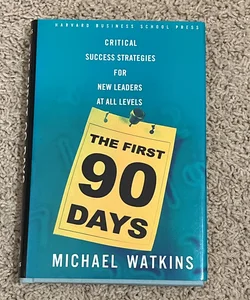Last night, I completed “The First 90 Days”, a book written by Michael D. Watkins. The book focuses on ten key strategies for a successful career transition.
To set the tone for discussion, the author highlights common transition traps that should be avoided. These include tending to stick with what you know and failing to understand that success in a new role requires new competencies. Others include the tendency to rush in and take action while neglecting to learn about your new role and environment, attempting to do too much at a time, and neglecting to build relationships with your work peers.
The book is divided into ten chapters and in each chapter, the author discusses one of these key strategies, beginning on an anecdotal note and using the story to explain his points. Each chapter contains exercises that the reader can use to practice what has been learned in the chapter.
So, while this book is primarily written for leaders transitioning into new roles or new organizations, there are still key takeaways that can be adopted by employees who aren’t necessarily assuming leadership roles but are transitioning into new jobs and workplaces. I’ll try to point out a few of them.
The first key takeaway is that when transitioning, it’s important to focus on preparing yourself for the new role. In preparing yourself, you’ll need to learn about the organization and its services and where you fit in the scheme of things. You’ll also need to identify the important people in the organization and aim to build productive working relationships vertically and horizontally. Preparing yourself will also require that you check in to ensure that expectations align as to what you will do on the job. All of these are things to be done at the onboarding stage, and you can execute them through thoughtful questioning and personal research.

The second takeaway is that at the beginning stage of working in a new organization, your first job is to learn and not to prove anything. Your job is to figure out what you need to know about your new workplace and learn as fast as you can. To accelerate your learning, the author recommends having a 90-day learning plan. Your learning plan will contain your learning agenda (that’s your learning priorities).
The next key takeaway is the need to find out what you think is important to your boss and aim to secure positive outcomes in those areas. Again, I think you can do this by asking thoughtful questions.
Another important takeaway is that you should aim to secure early wins within the first few months. It doesn’t have to be anything grandiose. It could be something as simple as executing an assigned task with precision. Aim to deliver on tasks in a way that communicates your capabilities, a good disposition to work, and your values. That’s how you build personal credibility.
These key takeaways are all discussed in detail in the first five chapters of the book.
The remaining five chapters are on managing people and team-building strategies. These later chapters offer tools for leaders who are transitioning into new roles and new organizations to manage their teams. The points in those chapters aren’t relevant if you aren’t in a mid-level or senior leadership position. You can always return to read them when you climb up the leadership rung.
Overall, I think this is one book everyone working in the corporate space should read. Whether you’re an entry-level staff or a manager at work, there are useful insights for you. Thus, I highly recommend it.



